The next-gen MacBook Pro with Retina Display Review
by Anand Lal Shimpi on June 23, 2012 4:14 AM EST- Posted in
- Mac
- Apple
- MacBook Pro
- Laptops
- Notebooks
The King of All Notebook Displays
For years Apple has been shipping some of the best displays in consumer notebooks, but the MacBook Pro’s Retina Display is in a league of its own. While I never liked the phrase “painted on” in reference to the iPad and iPhone Retina Displays, that’s the best way I can describe the effect the MacBook Pro’s Retina Display has on me. Text really does look painted on. The effect is really the result of two things.
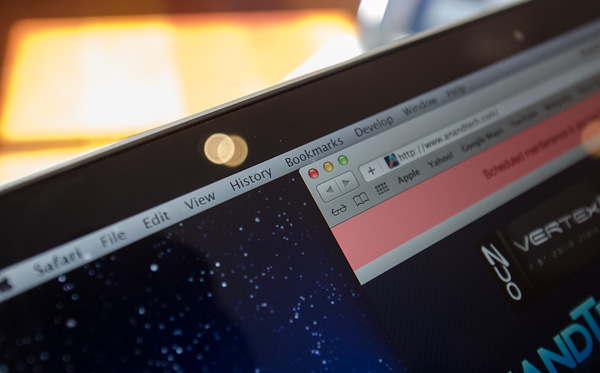
The first is Apple’s removal of its cover glass. LCD panels aren’t particularly attractive, they are ugly squares composed of two pieces of glass and a number of filters/polarizers. To hide the ugly edges, display makers wrap bezels around the display. Most people aren’t fond of bezels so next came a ton of effort to minimize bezel size. An alternative is to simply place a third piece of glass over the entire LCD assembly and make it look as if the bezel and LCD panel are integrated. This outermost layer is known as a cover glass and is what Apple uses on all of its glossy displays. If you’ve ever taken apart a Cinema/Thunderbolt Display or a newer iMac you’ll know that the cover glass is literally just a piece of glass that you have to remove with some suction cups.
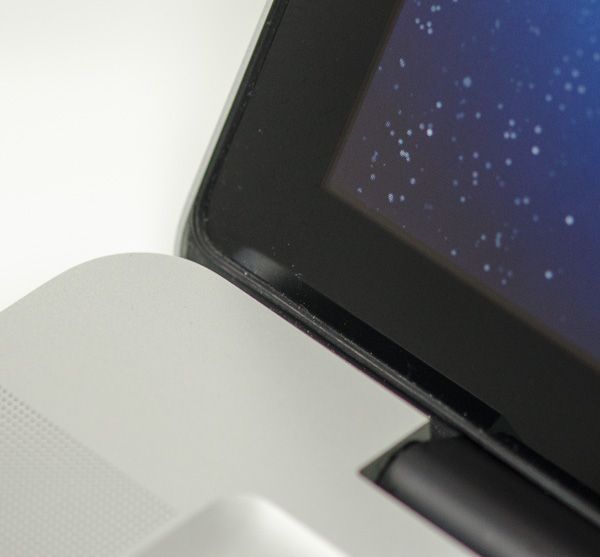
Non-Retina MacBook Pro, notice the gap between the outermost LCD glass and the cover glass
The MacBook Pro’s Retina Display does away with the cover glass and instead uses a fairly unique LCD assembly. There are still two pieces of glass but the outermost glass is actually a different size and shape - it integrates a bezel. By integrating the bezel into the outermost glass in the LCD stack you get the same effect as a cover glass but without the added reflections it introduces.
You also limit the possibility of dust getting trapped between the cover glass and the LCD. The danger is that you no longer have a protective piece of glass in front of your expensive new LCD. If you scratch the display you're scratching the LCD itself. While this has been true for conventional matte displays for a while, it's worth mentioning if you're used to Apple's glossy displays where you did have that added security layer.
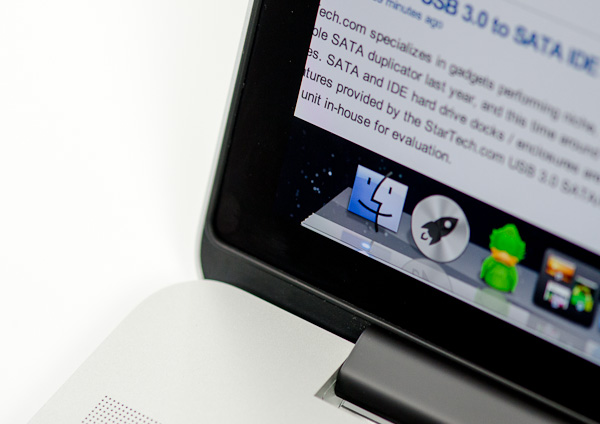
The MacBook Pro with Retina Display, no gap, no cover glass
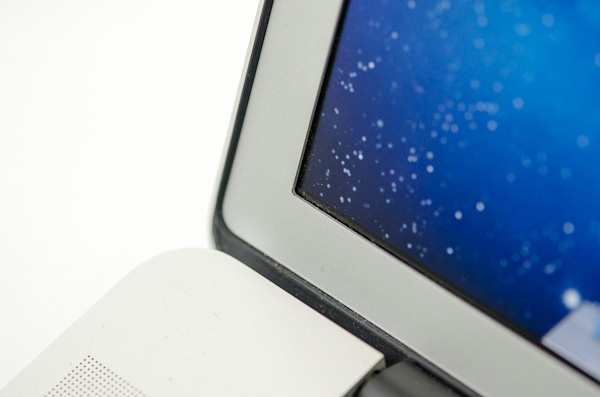
The 2011 MacBook Pro with High-Res Matte display option, no cover glass, top bezel

From left to right: 2010 High Res Glossy MBP, 2012 rMBP, 2011 High Res Matte MBP
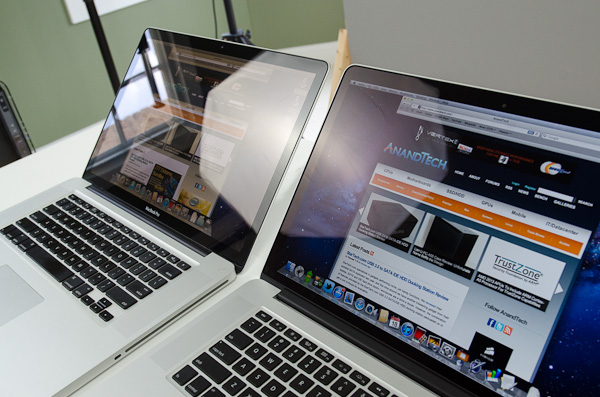
Glare handling indoors - 2011 High Res, Glossy MBP (left) vs 2012 rMBP (right)
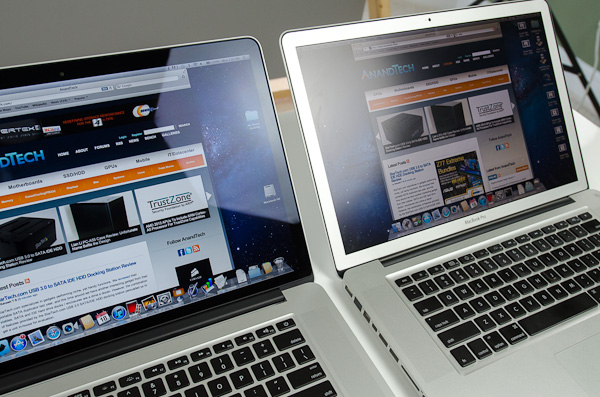
Glare handling indoors - 2012 rMBP (left) vs. 2011 High Res, Matte MBP (right)
The Retina Display is also obviously an extremely high resolution panel at 2880 x 1800. Note that this is 44.6% more pixels than Apple’s 27-inch Thunderbolt Display, and 26.6% more pixels than the 30-inch panels that we’ve loved for so long - all in a 15.4-inch notebook display.
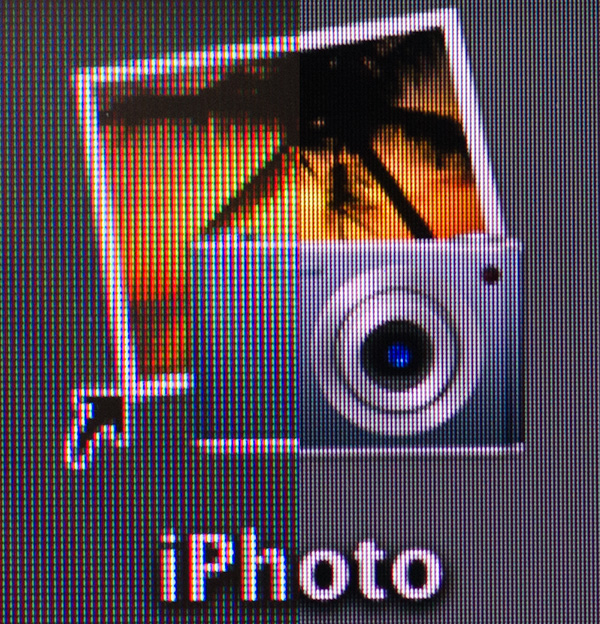
An iPhoto shortcut, High Res 2011 MBP (left) vs. Retina Display MBP (right)
At 220 pixels per inch it’s easily the highest density consumer notebook panel shipping today. At normal viewing distances and even with my face closer than I’m comfortable putting it I simply cannot discern individual pixels.
It’s the combination of these two elements, the removal of the cover glass and the insanely high pixel density that makes everything from text to UI elements just look painted on the new Retina Display. And the effect is gorgeous. I’ve never seen a prettier panel and it’s actually ruined me for pretty much all other displays, notebook and desktop.
While I can appreciate the iPad’s Retina Display, the impact from the MacBook Pro’s display is even more significant. Perhaps it’s because I still spend so much time working on a standard, non-tablet display, but I’m far more excited about this display than anything else Apple has delivered under the Retina moniker.
It’s not just pixel density that Apple has to offer here. Similar to its Retina Displays in the iPhone and iPad, the MacBook Pro’s Retina panel ditches TN in favor of IPS technology. The result is an incredible improvement in viewing angles. On a notebook I don’t spend a lot of time viewing it from far left/right angles, although I see the benefit when I’ve got others huddled around my display. Here the panel performs admirably - you lose brightness at far left/right angles but there’s no perceivable color shift. In fact, the painted on effect is even more impressive at these far left/right viewing angles.
For a single user however the more impressive characteristic is just how good the display looks at vertically off-center angles. I wrote much of the initial parts of this review while on an airplane in coach, which with a 15-inch notebook on my lap means I’m going to be looking at the display at a weird angle to begin with. The thinner rMBP doesn’t do enough to make the airplane usage model any better if the person in front of you decides to recline, but the IPS panel does make the display perfectly usable at the off-center angle you’ll inevitably have to deal with.
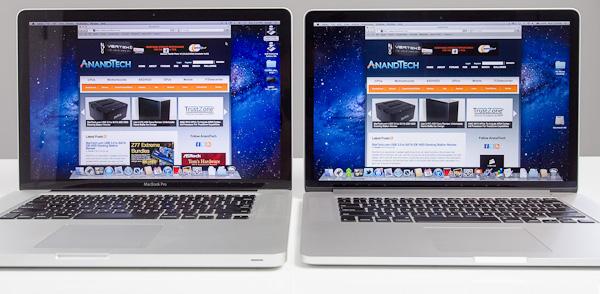
2010 High Res, Glossy MBP (left) vs. 2012 rMBP (right)
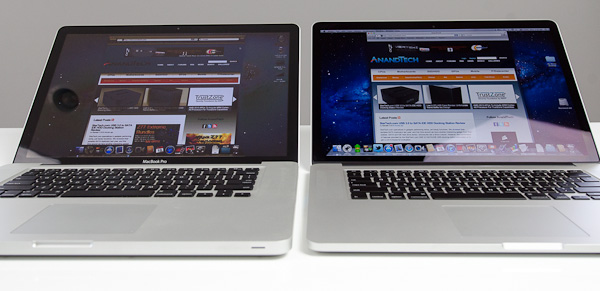
Hello colorshift!
2010 High Res, Glossy MBP (left) vs. 2012 rMBP (right)


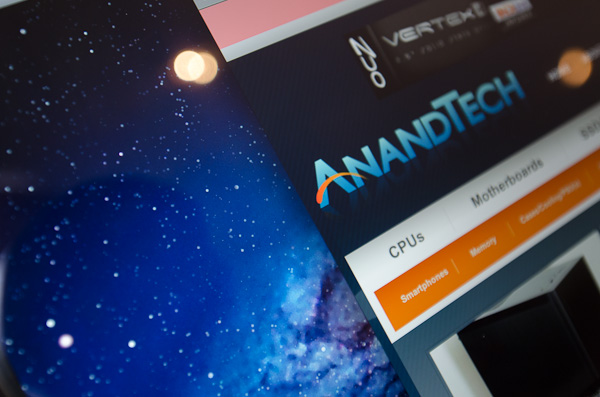
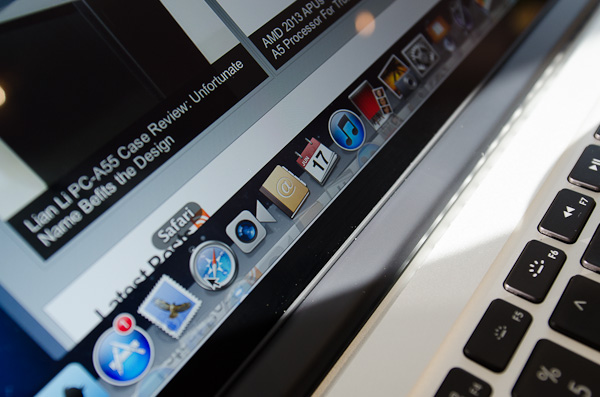
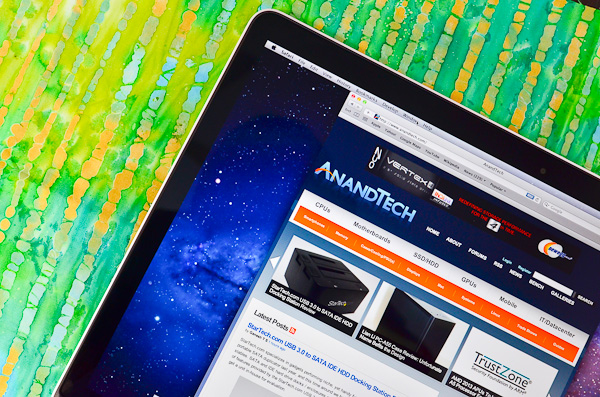
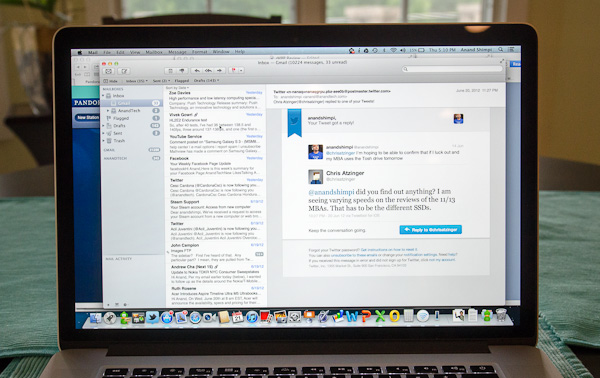
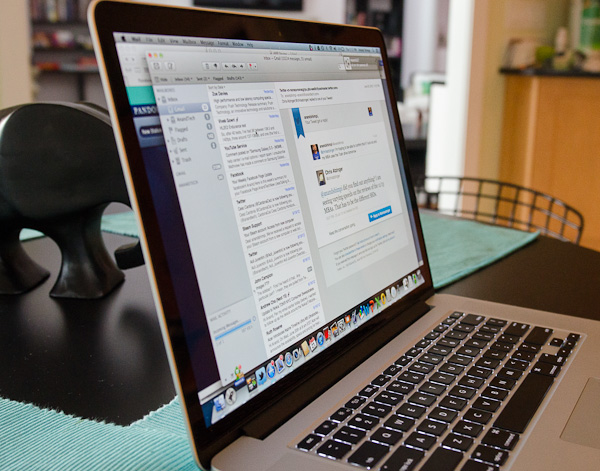








471 Comments
View All Comments
Fx1 - Monday, June 25, 2012 - link
Whine Whine Whine.In the UK we have the best warranty going thanks to UK Regulations and EU protection. Plus 3 year free on education discounts of which i have bought 2 MBP's and never set foot in a university in my life.
Just because in NZ you don't have that protection then blame your gov for not passing legislation.
Also why bitch about Ram? just put the 16GB in and then your good for the next 10 years i expect. £13 a year cost
Spunjji - Tuesday, June 26, 2012 - link
You're so full of shit it's bursting out at the seams. The NZ government have imposed much better consumer warranty protection than we have here in the UK. You might know that if you weren't a fucking cretin who spouts off nonsense before thinking. The fact that you seem to think it's his fault that he lives in NZ where Apple give shitty support just shows what a jingoistic little fanboy you are.That's also an interesting "£13 a year" theory. It'd be neat if it wasn't a complete and utter crock. If more than 10% of these laptops are used regularly for 10 years, Apple pixie magic included, then I will eat my goddamn chair. Maybe you should have gone to university, they could have slammed some sense into your tiny little skull.
Solidstate89 - Sunday, June 24, 2012 - link
"Apple’s impact on the industry has already been felt. The threat of Apple bringing Retina Displays to its entire lineup forced ASUS’ hand and gave us 1080p IPS panels in the new Zenbook Primes."Isn't that a little fucking arrogant to say with absolutely no proof to back that claim up? You know better than anyone how much design work goes into producing these products, and just how LONG the process takes. You really think in just a few months time of rumors, ASUS could have completely revamped their product line-up? Or maybe they were just doing it, because they had already started with the higher resolution displays on their tablet line-up? Or maybe they were even trying to match the absolutely superb and high density display that Sony has been using in their Vaio Z series for all these years.
Claiming just the RUMOR of Apple doing it was UNDOUBTEDLY the influence behind ASUS' IPS, high resolution screens is baseless bullshit. And you know it.
Iketh - Sunday, June 24, 2012 - link
what i don't get is how people could care so much to get pissed off like you... get a hobby!and i agree 100% with Anand's statement... you're blind to not agree, and i'm a PC developer
wfolta - Sunday, June 24, 2012 - link
ASUS may have decided to carry higher resolution displays from their tablets to their laptops, but Apple beat them to the punch with the retina iPad and the rumors of a retina Macbook have been around since at least that far back.Considering most manufacturers have reduced pixel density over time, and considering it was Apple that pushed the retina display first to the iPhone, then the iPad, I think the burden of proof is on you to say that these netbook makers were just itching for higher resolution.
In fact, most of them stopped at the stupid 16:9 1080p (1920x1080) resolution because that's what HD TVs have and they've wanted to tout their ability to play BluRay's at full resolution. There was no concept of making a beautiful display: it was all about a marketing checkbox. And that's what they guy is saying.
kmmatney - Sunday, June 24, 2012 - link
I'm a windows developer - have been for almost 20 years now. I also travel a lot so all my development is done on a laptop, across several virtual machines. I'm currently using a 2007 Dell 17" 1920 x 1200, and have not upgraded yet, waiting for another windows 1920 x 1200 laptop to surface. I've run out of hope now - if Apple comes out with a 17" version of this I'll have to try and convince my company to buy one. I've never used a Mac in my life, but will pay the "Apple tax" to get what I need hardware-wise. I currently have about 20 VMs packed onto a Samsung 256GB 830, so I'm good with storage space.The Windows laptop makers just don't get it - not everyone watch's movies all day - some of us want to use our machines for real work and want to have extra vertical space. Is it that hard to make a 16:10 screen? An ugraded screen is a "3D" screen - really?! The "True-life" screen on my old 2007 Dell is still better than anything you can get nowadays - I've directly compared it with co-corkers brand-new laptops.
KPOM - Sunday, June 24, 2012 - link
Is it possible that Apple's solution for making the rMBP work will scale to the new iPhone? In other words, does it offer Apple a way to increase the screen size without causing a break in compatibility between older and newer apps?gstrickler - Sunday, June 24, 2012 - link
The iPhone and iPad already handle the HiDPI displays, Apple deployed Retina displays there first. The scaling to non integer resolutions is definitely something Apple could do on the iPhone or iPad, but since it takes significantly more CPU/GPU power and affects both performance and battery life, I would not expect it anytime soon. If Apple goes to a larger screen on either device, it's likely that it will support the same total resolution as the current devices and have slightly lower dpi. If we see a 3.7"-4.3" iPhone display, I expect it to be 960x640, just like the current iPhone with Retina display.They already have 4 native resolutions to support on iDevices, 480x320 and 960x640 on iPhone, 1024x768 and 2048x1536 on iPad. I don't believe they'll want to increase that as it has an impact on the hardware, battery life, and every developer, so while it's possible, I think it's unlikely.
raclimja - Sunday, June 24, 2012 - link
Ingadgethrrmph - Sunday, June 24, 2012 - link
This one is *extremely* close to allowing me to replace a full tower workstation and my current laptop. Apple has built a very, very impressive machine that should be a wake-up call to the industry: Move forward, or be left behind.Even so, it falls slightly short of my ideal specs. If Apple would make the next one a 17" or 18" version (please make it Retina, I love the foresight there :), add a 10-Key section to the keyboard, upgrade to Giga-WiFi-ac-1.3Gbs, upgrade the quantity of internal drive ports (yes plural - I can use up to 5 immediately, if they will fit), and pretty please give us a standard drive connector.
While we're at it, can we have all of the drives running at speeds of at least 6.0Gbs? You know, like putting the drives on the current standard mSATA 6.0Gbs connectors, or even hooking them up to a better, newer, smaller, open standard connector at 12.0Gbs.
That's a lot to ask of course, but if they 'just' managed to make it a 17" Retina display, with three drives, with standard connectors, and WiFi-ac-800Mbs, and managed to do it this year, then I would feel they have done as much as anyone could do in in the time available.
If they miss out on delivering a 17" model this year, then it becomes more of a wide open competition where almost anyone could deliver a competitive product in the 17"+ space. After all, the display actually only has to be better than 1920 x 1200 to exceed the specs of my current laptop display.
Right now Apple appears to have the hardware lead and a fairly big one at that. If such a 17"+ machine appears, as described in any of the scenarios above, then it would solidify Apple's hardware lead. With a move like that, Apple would firmly and aggressively cement its position in every laptop screen size category that matters. They could have a compelling position in perhaps 99% of the laptop market.
It would also satisfy my need to have a portable large display machine that can go on infrequent, but very long trips, where I am sometimes remote, and I often need to be fairly self-sufficient and fault tolerant (ie: fix any of the inevitable data glitches myself).
It would improve my situation very significantly if there were sufficient physical drives to have separate system, data, and auto-backup drives internally. Also, having extremely capable external ports is important. So both keeping the existing wired ones just released on the current 15" Retina model, and adding the nascent WiFi-ac wireless internal hardware that is debuting this year in non-Apple equipment, would be super helpful for enhancing my ability for doing redundant off-machine data backups - just in case the internal auto-backup gets thrashed.
In fact if Apple were able to produce such a machine, I would be virtually forced - in a very pragmatic sense - to shell out the cash, move to the dark side, and purchase my first Apple product, ever.
Yes, after 25 years of computing I would lose my patience with the laggards that comprise the rest of the laptop market. With deep, naughty feelings of dark misgiving, I would both splurge and switch allegiance at the same time. I wonder how many others would do the same?
If this should come to pass, then I would inevitably wonder if Apple's real intentions are as wicked as I fear: To eventually try to lock all of us as 'sheeple', into a proprietary hell on Earth. You know... like Sony's thankfully failed attempts to force 'works only here' on us. Umm... let's see... MMC Memory Sticks, anyone?.
Well, back to Apple: Just sayin'... I would do it... even though I know better.
Hey... isn't Microsoft supposed to be getting back into the hardware business in a big way?
What do you think the chances are of a company like Microsoft and a machine like that...
So you're telling me there's a chance... *YEAH!*
-